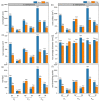Invasive and Native Plants Differentially Respond to Exogenous Phosphorus Addition in Root Growth and Nutrition Regulated by Arbuscular Mycorrhizal Fungi
- PMID: 37299174
- PMCID: PMC10255820
- DOI: 10.3390/plants12112195
Invasive and Native Plants Differentially Respond to Exogenous Phosphorus Addition in Root Growth and Nutrition Regulated by Arbuscular Mycorrhizal Fungi
Abstract
Plant invasion has severely damaged ecosystem stability and species diversity worldwide. The cooperation between arbuscular mycorrhizal fungi (AMF) and plant roots is often affected by changes in the external environment. Exogenous phosphorus (P) addition can alter the root absorption of soil resources, thus regulating the root growth and development of exotic and native plants. However, it remains unclear how exogenous P addition regulates the root growth and development of exotic and native plants mediated by AMF, affecting the exotic plant invasion. In this experiment, the invasive plant Eupatorium adenophorum and native plant Eupatorium lindleyanum were selected and cultured under intraspecific (Intra-) competition and interspecific (Inter-) competition conditions, involving inoculation with (M+) and without AMF (M-) and three different levels of P addition including no addition (P0), addition with 15 mg P kg-1 soil (P15), and addition with 25 mg P kg-1 soil (P25) for the two species. Root traits of the two species were analyzed to study the response of the two species' roots to AMF inoculation and P addition. The results showed that AMF significantly promoted the root biomass, length, surface area, volume, tips, branching points, and carbon (C), nitrogen (N), and P accumulation of the two species. Under M+ treatment, the Inter- competition decreased the root growth and nutrient accumulation of invasive E. adenophorum but increased the root growth and nutrient accumulation of native E. lindleyanum relative to the Intra- competition. Meanwhile, the exotic and native plants responded differently to P addition, exhibiting root growth and nutrient accumulation of invasive E. adenophorum increased with P addition, whereas native E. lindleyanum reduced with P addition. Further, the root growth and nutrition accumulation of native E. lindleyanum were higher than invasive E. adenophorum under Inter- competition. In conclusion, exogenous P addition promoted the invasive plant but reduced the native plant in root growth and nutrient accumulation regulated by AMF, although the native plant outcompeted the invasive plant when the two species competed. The findings provide a critical perspective that the anthropogenic P fertilizer addition might potentially contribute to the successful invasion of exotic plants.
Keywords: arbuscular mycorrhizal fungi; competition; phosphorus addition; plant invasion; root trait.
Conflict of interest statement
The authors declare there are no conflict of interest.
Figures






Similar articles
-
Arbuscular mycorrhizal fungi improve the competitive advantage of a native plant relative to a congeneric invasive plant in growth and nutrition.Ecol Evol. 2024 May 21;14(5):e11459. doi: 10.1002/ece3.11459. eCollection 2024 May. Ecol Evol. 2024. PMID: 38774145 Free PMC article.
-
An invasive plant experiences greater benefits of root morphology from enhancing nutrient competition associated with arbuscular mycorrhizae in karst soil than a native plant.PLoS One. 2020 Jun 9;15(6):e0234410. doi: 10.1371/journal.pone.0234410. eCollection 2020. PLoS One. 2020. PMID: 32516341 Free PMC article.
-
AM fungi facilitate the competitive growth of two invasive plant species, Ambrosia artemisiifolia and Bidens pilosa.Mycorrhiza. 2018 Nov;28(8):703-715. doi: 10.1007/s00572-018-0866-4. Epub 2018 Sep 15. Mycorrhiza. 2018. PMID: 30220052
-
Influence of arbuscular mycorrhizal fungi on bioaccumulation and bioavailability of As and Cd: A meta-analysis.Environ Pollut. 2023 Jan 1;316(Pt 1):120619. doi: 10.1016/j.envpol.2022.120619. Epub 2022 Nov 17. Environ Pollut. 2023. PMID: 36403873 Review.
-
Alleviating Plant Density and Salinity Stress in Moringa oleifera Using Arbuscular Mycorrhizal Fungi: A Review.J Fungi (Basel). 2025 Apr 21;11(4):328. doi: 10.3390/jof11040328. J Fungi (Basel). 2025. PMID: 40278148 Free PMC article. Review.
Cited by
-
The Role of Mycorrhizal Fungi in the Inter and Intraspecific Competition of Nicotiana glauca and Vachellia gerrardii.Plants (Basel). 2025 Mar 10;14(6):858. doi: 10.3390/plants14060858. Plants (Basel). 2025. PMID: 40265759 Free PMC article.
References
-
- Ni M., Liu Y., Chu C., Xu H., Fang S. Fast seedling root growth leads to competitive superiority of invasive plants. Biol. Invasions. 2018;20:1821–1832. doi: 10.1007/s10530-018-1664-9. - DOI
-
- Xia T., Wang Y., He Y., Wu C., Shen K., Tan Q., Kang L., Guo Y., Wu B., Han X. An invasive plant experiences greater benefits of root morphology from enhancing nutrient competition associated with arbuscular mycorrhizae in karst soil than a native plant. PLoS ONE. 2020;15:e0234410. doi: 10.1371/journal.pone.0234410. - DOI - PMC - PubMed
-
- Morris T.L., Esler K.J., Barger N.N., Jacobs S.M., Cramer M.D. Ecophysiological traits associated with the competitive ability of invasive Australian acacias. Divers. Distrib. 2011;17:898–910. doi: 10.1111/j.1472-4642.2011.00802.x. - DOI
Grants and funding
LinkOut - more resources
Full Text Sources

